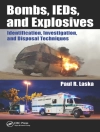Critical Issues in Crime and Justice: Thought, Policy, and Practice provides an incisive overview of issues and perspectives in criminal justice and criminology designed to expand upon key areas of study.
With contributed essays from leading scholars in the field, the
Third Edition illustrates the breadth of research, policy, and practice implications in areas such as crime theory, law enforcement, jurisprudence, corrections, and criminal justice organization and management. New to this edition are chapters on wrongful convictions, human trafficking, and mental illness and criminal justice, three critical issues facing contemporary policing, courts, and corrections.
The coverage of concepts, insights, voices, and perspectives will challenge criminal justice and criminology students to synthesize what they have learned, question standard interpretations, and begin to create new directions and visions for their future careers as professionals in the field.
Cuprins
Preface for the Third Edition
Acknowledgments
1. Introduction : Is It Possible to Prepare for a Criminal Justice Future? – Dan Okada
PART I. ORIENTATION
2. The Importance of Ethics in Criminal Justice – Cyndi Banks
Police Ethics
Discrimination
Legal Ethics
Punishment
Correctional Ethics
Ethical Criminal Justice Policy Making
Analyzing Ethical Dilemmas
Conclusion
Discussion Questions
References
3. Unleashing the Power of Criminal Justice Theory – Peter B. Kraska
The Power of Criminal Justice Theory for Our Discipline
Criminal Justice: A Worthy Object of Theorizing
Developing a Useful Theoretical Infrastructure
The Power of Theory to Transform Consciousness
The Power of Theory to Affect Public Explanations
Conclusion: Embracing Criminal Justice Theory
Discussion Questions
References
PART II. OFFENSES AND OFFENDERS
4. Victimology – Leah E. Daigle
The Typical Victimization and Victim
The Costs of Victimization
System Costs
Mental Health Consequences and Costs
Fear of Crime
Recurring Victimization
Theories of Victimization
Routine Activities and Lifestyles Theories
Structural Causes of Victimization
Caring for the Victim
Victim Remedies and Services
Summary
Discussion Questions
References
5. Juvenile Delinquency – David L. Parry
What Is Delinquency?
How Much Delinquency?
Arrest Data
Self-Report Surveys
Adolescent Development, Risk Factors, and Pathways to Delinquency
Normal Adolescent Behavior?
Risk and Protective Factors
Pathways to Delinquency
Different for Girls?
Discussion
Discussion Questions
Notes
References
6. Gender Matters: Trends in Girls’ Criminality – Meda Chesney-Lind
Crime Wave?
Delinquency: Gender Matters
Girls’ Crime, Girls’ Offenses
Girls’ Violence: When She Was Bad
Running Away: Girls Coping With Trauma and Abuse
Wild in the Streets: Girls, Drugs, and Alcohol
Shoplifting: You Shoplift as You Shop
Conclusion
Discussion Questions
References
7. Race and Crime – Helen Taylor-Greene
Definitional Complexities
Theoretical Perspectives on Race and Crime
Contemporary Issues in the Study of Race and Crime
Future Issues in the Study of Race and Crime
Discussion Questions
Web Resources
References
8. Popular Culture, Media, and Crime – Richelle S. Swan
Popular Theoretical Approaches to the Study of Popular Culture, Media, and Crime
Popular Methodological Approaches Used in the Study of Popular Culture, Media, and Crime
Important Research Themes in Studies of Popular Culture, Media, and Crime
Framing Gone Extreme: Moral Panics About Crime, Delinquency, and Popular Culture
Effects of Popular Culture and Media Consumption on Crime
Being Framed: The Skewed Representation of Social Groups in Crime Media and Entertainment
Mediating Oneself: Using Media and Popular Cultural Forms to Communicate Messages About Crime and Justice
Discussion Questions
References
9. Crime and Economics: Consumer Culture, Criminology, and the Politics of Exclusion – Stephen L. Muzzatti and Maggie Reid
A Specter Is Haunting Criminology . . .
Reading the Profane: Theorizing Crime and Capitalism
Banality and Viciousness in Late Modernity
Consuming Crime and Culture
Late Modernity, Crime, and Pseudopacification
Selling Crime, Marketing Transgression, and Commodifying Violence
Conclusion: Nothing to Lose But Our Chains
Discussion Questions
Notes
References
10. Serious Gang Problems in the United States: What to Do? – James C. Howell and Megan Qually Howell
Gang Definitions
Key Indicators of Serious Gang Activity
Contexts of Serious Gang Violence
Other Factors Associated With Gang Violence
Juvenile and Criminal Justice System Involvement of Gang Members
What Works in Combating Gang Violence
Discussion Questions
Notes
References
11. Sex Offender Policies: Good Intentions and Unintended Consequences – Alexa Sardina
Sex Offender Registration and Community Notification Laws
Does the Registry Prevent Sex Offenses?
Unintended Consequences of Registration, Notification, and Residence Restrictions Laws
The Civil Commitment of Sexually Violent Predators
Conclusion
Discussion Questions
Web Resources
References
12. Issues in the Fight Against Human Exploitation: A Look at Labor and Sex Trafficking – Casey Branchini
Human Trafficking Defined
Magnitude of the Problem
Prosecution of Trafficking Crimes
Obstacles to the Prosecution of Trafficking Crimes
Conclusion
Discussion Questions
Additional Resources
References
13. Terrorism – C. Augustus Martin
The Challenge of Defining Terrorism
What Is “New” About the New Terrorism?
Terrorism in the United States: The International Sources
Terrorism in the United States: The Domestic Sources
Responding to Terrorism: Homeland Security and Antiterrorism Laws
Discussion Questions
Notes
References
14. Critical Issues in Cybercrime – Johnny Nhan
Critical Issue: Hacking and Computer Network Security
Critical Issue: Darknets and the Deep Web
Critical Issue: The Internet Culture and Ethos
Research: Understanding Hackers’ Motivations
Critical Issue: Policing Cyberspace
Critical Issue: Digital Piracy
Critical Issue: Cyberbullying
Conclusion
Discussion Questions
References
PART III. POLICING/LAW ENFORCEMENT
15. Police Theory: Major Perspectives – Dawn M. Irlbeck, Connie M. Koski, and John P. Crank
Normative-Rational Theory
Institutional Theory
Conflict Theory
Postmodernism
Conclusion
Discussion Questions
References
16. A Vision of Contemporary Policing: Present Practices and Future Developments – Gennaro F. Vito
Paradigms in Policing
The British Paradigm: Balancing Democratic Principles and the Military Model
Early American Police Paradigms
The Political Era Paradigm
The Reform Era Paradigm
Minorities and the Police
The Community and Problem-Oriented Policing Paradigms
The Comp Stat Paradigm
The Intelligence-Led Policing Paradigm
The Smart Policing Initiative
Conclusion
Discussion Questions
References
17. Police Organization and Administration – Thomas Nolan
Origins of the Structural Model of Police Organizations
The Police and Militarization
Police Organization: Subculture, Ethos, and Milieu
Organization and Subculture: Initiation and Masculinism
Organizational Subculture and Moral Superiority
Police Organization: Autonomy and Authoritarianism
Federal Oversight of the Police
Police Administration and the Civil Service
Police Administration and Unions
The Police
Discussion Questions
Suggested Readings
Notes
References
PART IV. COURTS/LAW/JURISPRUDENCE
18. Public Policy – Janice Ahmad
Public Policy: The Formal Version
Sources of Criminal Justice Policy
Public Policy as It Is in Practice
The Use and Misuse of Public Policy
The Policy Implications of Public Policy
The Politicization of Public Policy
The Contributions of Academic Criminal Justice
Conclusion
Discussion Questions
Note From the Author
References
19. American Courts – Cassia Spohn
Supreme Court Decisions and American Courts
The Sentencing Reform Movement
Specialized or Problem-Solving Courts: A Focus on Drug Courts
Conclusion: Policy Implications
Discussion Questions
Notes
References
20. The Juvenile Justice System – Randall G. Shelden
Detention Centers
Special Issues Facing the Juvenile Justice System
Race, the War on Drugs, and Referrals to Juvenile Court
The Racial Composition of Juvenile Institutions
The Future of the Juvenile Court
Discussion Questions
Notes
References
21. Why Are There So Many Mentally Ill in the Criminal Justice System? – Jennie K. Singer and Chelsea M. Johnson
Prevalence of Mentally Ill Offenders
Are Jails and Prisons the New Mental Hospitals, or Are We Criminalizing Mental Illness?
The SMI Stay Longer in Jails and Prisons
The SMI in the Community: More Difficulty on Probation or on Parole?
Conclusion
Discussion Questions
Note
References
22. Wrongful Convictions in the United States – Kim Schnurbush
Scope of Wrongful Convictions
History of Wrongful Convictions in the United States
Wrongful Conviction/Exoneration Case Examples
Wrongful Conviction Organizations/Movements
Conclusion
Discussion Questions
References
PART V. CORRECTIONS
23. The Philosophical and Ideological Underpinnings of Corrections – Anthony Walsh and Ilhong Yun
What Is Corrections?
The Theoretical Underpinnings of Corrections
A Short History of Correctional Punishment
The Emergence of the Classical School
The Emergence of Positivism
The Function of Punishment
The Objectives of Corrections
The Past, Present, and Future of Corrections
Summary
Discussion Questions
References
24. Community Corrections: Rehabilitation, Reintegration, and Reentry – Ming-Li Hsieh
The Common Forms of Community Corrections
Probation: Progressive Reform and the Promise of Rehabilitation
Parole as Reward or Relief
Concerns Regarding Stakes: Risk Assessment and Prediction
Worse Than Prison?
Reintegration and Reentry
Factors Associated With Community Supervision Success and Failure
Ongoing Debates and Policy Implications
Conclusion
Discussion Questions
References
25. Restorative Justice in Theory – Lois Presser and Kyle Letteney
What Is Restorative Justice?
How Is Restorative Justice Supposed to Work?
Conclusions
Discussion Questions
Notes
References
26. Garbage In, Garbage Out? Convict Criminology, the Convict Code, and Participatory Prison Reform – Alan Mobley
Mass Incarceration in America
Convict Criminology
The Convict Code
Factors Undermining the Convict Code/Formal Structure
A New Code
Discussion Questions
Note From the Author
References
Index
About the Editors
About the Contributors
Despre autor
Alexa Sardina is an Assistant Professor in the Division of Criminal Justice at California State University California. Her research interests include: sex offender motivation, offense cycles, and the use of restorative justice models in cases of rape and sexual assault. Her recent work has been published in: The Journal of Offender Rehabilitation and International Journal of Offender Therapy and Comparative Criminology.












